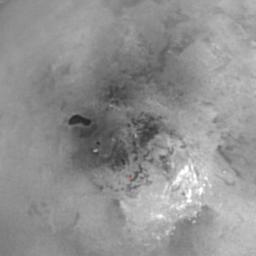
|
Land of Lakes?
- Click the image above for a larger view
- Full-Res JPEG (967 x 969) (55.8 kB)
- Full-Res TIFF (967 x 969) (2.8 MB)
Caption:
This view of Titan's south pole reveals the intriguing dark feature named Ontario Lacus and a host of smaller features dotting the south polar region.
The true nature of this feature, seen here at left of center, is not yet known with absolute certainty. However, the feature's darkness, the shore-like smoothness of its perimeter, and its presence in an area where frequent convective storm clouds have been observed by Cassini and Earth-based astronomers made it the best candidate for an open body of liquid on Titan when this image was taken in June 2005.
This interpretation has been strengthened by the sighting of features having similar morphologies in Titan's northern polar region during the flyby of Titan in late February (see PIA08365 ). The possibility that these northern features, the sizes of small seas, are either completely or partially filled with liquid hydrocarbons is significantly strengthened by Cassini radar data that overlap portions of the Imaging Science Subsystem-observed northern bodies, (see PIA09182 ).
Previously, scientists had speculated that Ontario Lacus might simply be a broad depression filled by dark, solid hydrocarbons falling from the atmosphere onto Titan's surface. In this case, the smoothed outline might be the result of a process unrelated to rainfall, such as a sinkhole or a volcanic caldera. However, the strong likelihood that the northern polar features are lakes and seas has made imaging scientists more confident that Ontario Lacus, and the smaller dark features dotting the southern polar region of Titan, also hold liquid. If correct, this new revelation would mean that each pole on Titan is a large wetlands area.
The feature is named for Lake Ontario because its shape and length are similar, though the Titan feature is much wider. In actual surface area, the feature is roughly the size of Lake Victoria. However, if the relative sizes of Titan and Earth are accounted for, Ontario Lacus covers roughly the same fraction of Titan as does the Black Sea on Earth.
A red cross below the center in the scene marks the pole. The brightest features seen here are methane clouds. A movie sequence showing the evolution of bright clouds in the region during the same flyby is also available (see PIA06241 ).
This view is a composite of three narrow-angle camera images, taken over several minutes during Cassini's distant June 6, 2005, flyby. The images were combined to produce a sharper view of Titan's surface. The images were taken using a combination of spectral filters sensitive to wavelengths of polarized infrared light. The images were acquired from approximately 450,000 kilometers (279,000 miles) from Titan. Resolution in the scene is approximately 3 kilometers (2 miles) per pixel. The view has been contrast enhanced to improve the overall visibility of surface features.
Background Info:
The Cassini-Huygens mission is a cooperative project of NASA, the European Space Agency and the Italian Space Agency. The Jet Propulsion Laboratory, a division of the California Institute of Technology in Pasadena, manages the mission for NASA's Science Mission Directorate, Washington, D.C. The Cassini orbiter and its two onboard cameras were designed, developed and assembled at JPL. The imaging team is based at the Space Science Institute, Boulder, Colo.
For more information about the Cassini-Huygens mission visit http://saturn.jpl.nasa.gov . For additional images visit the Cassini imaging team homepage http://ciclops.org .
Cataloging Keywords:
| Name | Value | Additional Values |
|---|---|---|
| Target | Titan | |
| System | Saturn | |
| Target Type | Satellite | |
| Mission | Cassini-Huygens | |
| Instrument Host | Cassini Orbiter | |
| Host Type | Orbiter | |
| Instrument | Imaging Science Subsystem (ISS) | |
| Detector | Narrow Angle Camera | |
| Extra Keywords | Atmosphere, Color, Infrared, Methane, Radar, Storm, Visual, Volcano | |
| Acquisition Date | ||
| Release Date | 2005-06-28 | |
| Date in Caption | 2005-06-06 | |
| Image Credit | NASA/JPL/Space Science Institute | |
| Source | photojournal.jpl.nasa.gov/catalog/PIA06240 | |
| Identifier | PIA06240 | |
